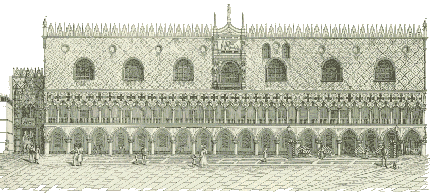Venezia - Palazzo Ducale

The Ducal Palace was the residence of the Doge up to the fall of the Venetian Republic in I797 a public palace and seat of the administration of justice. the highest and richest symbol of Venetian civilisation, of its cultural, military, political and economic history. All historic periods are represented in an extraordinary stratification of structural and decorative elements: from the antique foundations of the original Gothic complex, to the great halls dedicated to political life and decorated by the canvases of Veronese. Tintoretto and the great masters of the Renaissance. to the precious rooms of the Doges apartment, from the dark prisons and places of torture to the luminous loggias on the Piazza and the Lagoon.
ITINERARIES
THE MUSEO DELL'OPERA. Here are conserved the original late Gothic columns and capitals from the ground-level portico and the loggia on the south and west sides of the Palace, replaced with reproductions in the second half of the XIXth century, following a grandiose restoration campaign. These works constitute one of the most suggestive examples for the appreciation of the art and the fantastic iconographic world of the Lombard and Veneto stonemasons who worked in Venice in the XIVth and XVth centuries.
THE PALACE. The itinerary unfolds through the halls which were the seat of the organs of Government of the Republic: the Collegio, the Senate, the Council of Ten, the Maggior Consiglio. The splendid interior decoration, both majestic and scenographic, is the work of the major masters of Venetian painting, such as Titian, Tintoretto and Veronese. The itinerary includes a visit to the Armoury.
THE DUCAL APARTMENT. The Golden Staircase gives access to the Apartment of the Doges, where the Venetian Government imposed residence upon the highest authority and together the symbol itself of the State. The Apartment, located in a position which allowed both rapid horizontal and vertical connections with the most important places of the political life of the Palace, is decorated with splendid sculpted fireplaces and with canvases by the major artists of the Venetian school.
THE PRISONS. Connected to the sumptuous halls of the Palace through the Bridge of Sighs, the "New Prisons" embody the harsh and inflexible aspect of Venetian civilisation, its Justice. The itinerary leads to the discovery of these cramped places of detention, where graffiti by the ancient prisoners may still be seen.
THE SECRET ITINERARIES. This itinerary unfolds in the areas of the Palace which were excluded from the opulent scenographic rituals of the Republic, where the anonymous daily work of the state burocracy took place. The itinerary, among other things, shows the rooms where the prisoners were interrogated and the torture chamber, and through a labyrinthian network of tortuous passages, leads down into the most secret meanders of the Palace.